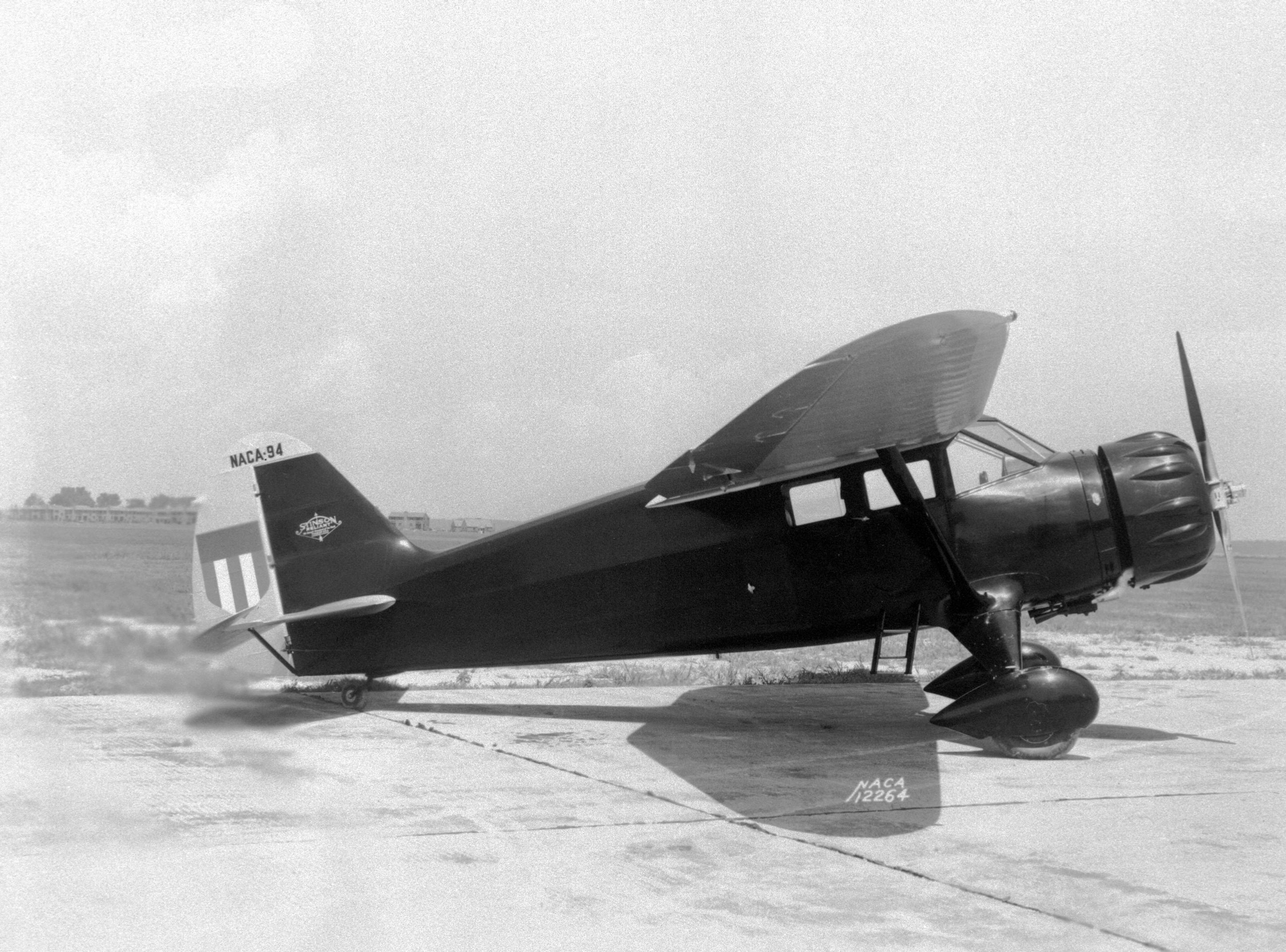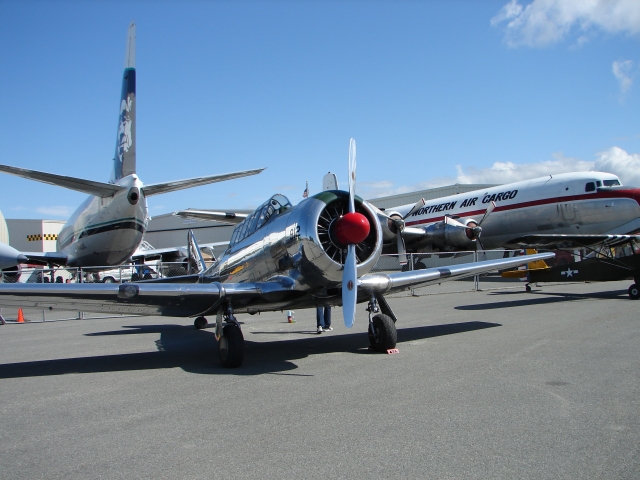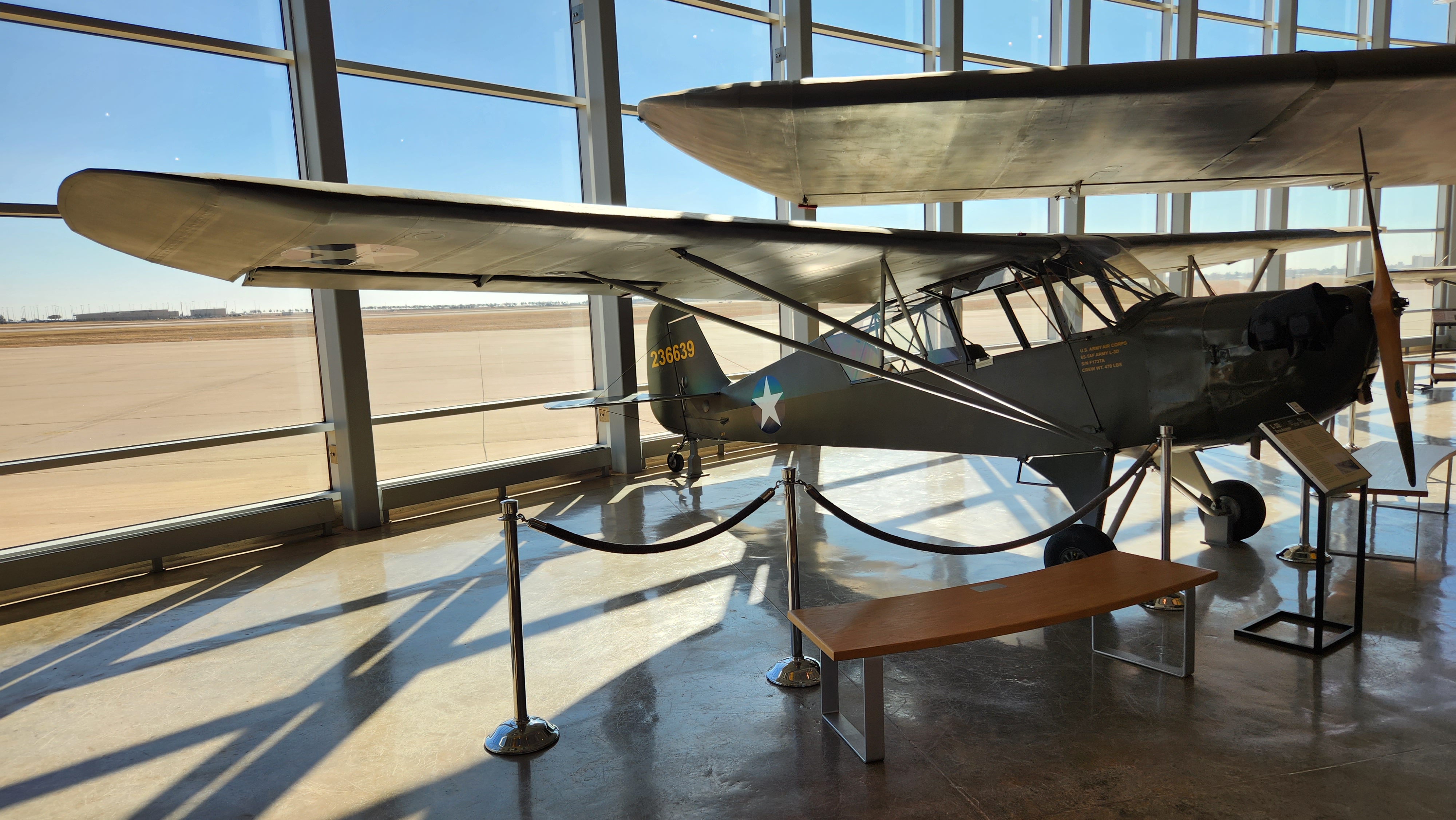|
L-1 Vigilant
The Stinson L-1 Vigilant (company designation Model 74) is an American liaison aircraft designed by the Stinson Aircraft Company of Wayne, Michigan and manufactured at the Vultee-Stinson factory in Nashville, Tennessee (in August 1940 Stinson became a division of Vultee Aircraft Corporation). The aircraft was operated by the United States Army Air Corps as the O-49 until 1942. Design and development The Vigilant was designed in response to a 1938 United States Army Air Corps design competition for a two-seat light observation aircraft. After the German-manufactured Fieseler Storch was demonstrated at the 4th International Air Meet in Zurich, Switzerland in 1937, the Air Corps Material Division at Wright Field initiated a feasibility study for the creation of a similar aircraft. The development program was approved in January 1938, design and performance specifications were determined in April 1938, and a Circular Proposal for a formal design competition was released to manufactu ... [...More Info...] [...Related Items...] OR: [Wikipedia] [Google] [Baidu] |
Stinson Aircraft Company
The Stinson Aircraft Company was an aircraft manufacturing company in the United States between the 1920s and the 1950s. History The Stinson Aircraft Company was founded in Dayton, Ohio, in 1920 by aviator Edward Stinson, Edward “Eddie” Stinson, the brother of aviator Katherine Stinson. After five years of business ventures, Eddie made Detroit, Michigan the focus of his future flying endeavors while still flying as a stunt pilot, earning $100,000 a year for his efforts — a huge sum in those days. Stinson found Detroit's business community receptive to his plans to develop his own airplane. Alfred V. Verville and a group of local businessmen — the Detroit Board of Commerce's Aviation Committee — supported Stinson's plans to establish the Stinson Aircraft Syndicate in 1925, and provided $25,000 to design and build a prototype, an enclosed cockpit, 4-place biplane, powered by a Wright Whirlwind J-4 air-cooled radial engine test flighted at Packard Field in Roseville, ... [...More Info...] [...Related Items...] OR: [Wikipedia] [Google] [Baidu] |
Lend-Lease Act
Lend-Lease, formally the Lend-Lease Act and introduced as An Act to Promote the Defense of the United States (),"Lend-Lease Act (1941)," in ''Milestone Documents,'' National Archives of the United States, Washington, D.C., retrieved February 8, 2024; (notes: ''"Passed on March 11, 1941, this act set up a system that would allow the United States to lend or lease war supplies to any nation deemed 'vital to the defense of the United States.'"''; contains photo of the original bill, H.R. 1776, January 10, 1941, which referred to itself as "''An Act to Promote the Defense of the United States.''" ) was a policy under which the |
Blaine, Minnesota
Blaine is a suburban city in Anoka and Ramsey counties in Minnesota, United States. Once a rural town, Blaine's population has increased significantly in the last 60 years. For several years, Blaine led the Twin Cities metro region in new home construction. The population was 70,222 at the 2020 census. The city is mainly in Anoka County, and is part of the Minneapolis–Saint Paul metropolitan area. Interstate 35W, U.S. Highway 10, and Minnesota State Highway 65 are three of the main routes in the city. History Phillip Leddy, a native of Ireland, was recorded in the 1857 census as having settled in the township of Anoka until his death in 1872, on land that later became Blaine. In 1862, he moved near a lake that now bears his misspelled name, Laddie Lake. Another early settler was the Englishman George Townsend, who lived for a short time near what today is Lever St. and 103rd Ave. In 1865, Blaine's first permanent resident, Greenberry Chambers, settled on the old Townsen ... [...More Info...] [...Related Items...] OR: [Wikipedia] [Google] [Baidu] |
Anchorage, Alaska
Anchorage, officially the Municipality of Anchorage, is the List of cities in Alaska, most populous city in the U.S. state of Alaska. With a population of 291,247 at the 2020 United States census, 2020 census, it contains nearly 40 percent of the state's population. The Anchorage metropolitan area, which includes Anchorage and the neighboring Matanuska-Susitna Borough, Alaska, Matanuska-Susitna Borough, had a population of 398,328 in 2020, accounting for more than half the state's population. At of land area, the city is the List of cities in the United States by area, fourth-largest by area in the U.S. Anchorage is in Southcentral Alaska, at the terminus of the Cook Inlet, on a peninsula formed by the Knik Arm to the north and the Turnagain Arm to the south. First settled as a tent city near the mouth of Ship Creek, Alaska, Ship Creek in 1915 when construction on the Alaska Railroad began, Anchorage was incorporated as a city in November 1920. In September 1975, the City of A ... [...More Info...] [...Related Items...] OR: [Wikipedia] [Google] [Baidu] |
Alaska Aviation Heritage Museum
The Alaska Aviation Museum, previously the Alaska Aviation Heritage Museum, is located on Lake Hood Seaplane Base in Anchorage, Alaska. Its mission since 1988, is to preserve, display, and honor Alaska's aviation heritage, by preserving and displaying historic aircraft, artifacts, and memorabilia, and to foster public interest in aviation and its history. The museum has over thirty aircraft on display, a restoration hangar, flight simulators, two theaters, and a Hall of Fame. It provides an emphasis on historic aircraft, aviation artifacts, and memorabilia that contributed to the development and progress of aviation in Alaska, including Bush flying, and the World War II Army base on Adak Island. Overview The museum is made up of the Main, Rasmuson, South, and Restoration Hangars; as well as a shelter. Also on display is the air traffic control tower cab used at Merrill Field from 1962 to 2002. Exhibits include theaters, flight simulator, simulators and an art gallery. History The ... [...More Info...] [...Related Items...] OR: [Wikipedia] [Google] [Baidu] |
Polk City, Florida
Polk City is a city in Polk County, Florida, Polk County, Florida, United States. It is part of the Lakeland, Florida, Lakeland–Winter Haven, Florida, Winter Haven Lakeland-Winter Haven, Florida Metropolitan Statistical Area, metropolitan statistical area. Its population was 2,713 at the 2020 census. History Polk City was incorporated as the Town of Polk City in 1925, and changed by ordinance to the City of Polk City in 2005. The city was named after the county, itself named after James Knox Polk, the 11th President of the United States. Geography The exact coordinates for the City of Polk City are . According to the United States Census Bureau, the city has a total area of , all land. Polk City is located within the Central Florida Highlands area of the Atlantic coastal plain, with a terrain consisting of flatland interspersed with gently rolling hills. Climate The climate for the City of Polk City is characterized by hot, humid summers and generally mild to cool wint ... [...More Info...] [...Related Items...] OR: [Wikipedia] [Google] [Baidu] |
Fantasy Of Flight
Fantasy of Flight is an aviation museum in Polk City, Florida. It opened in November 1995, to house Kermit Weeks' collection of aircraft that, until Hurricane Andrew damaged many in 1992, were housed at the Weeks Air Museum in Kendall-Tamiami Executive Airport, Tamiami, Florida. On April 6, 2014, it closed to the public, aside from private events and on January 30, 2015, it opened a scaled-down museum displaying a small selection of aircraft while the facility is upgraded for a future reopening. Many of the aircraft displayed are airworthy and some are flown from the facility's grass runways or its seaplane runway. Facility The facility's main buildings consist of the two large "North" and "South" hangars where aircraft are displayed, the restoration shops, an immersion environment, the gift shop, and the Compass Rose, an Art Deco diner. Across from the entrance are a ropes course and zip line amusements. Adjoining the hangars there is a tarmac and two grass runways. On the ... [...More Info...] [...Related Items...] OR: [Wikipedia] [Google] [Baidu] |
Stinson 0-49 At Patterson Field During World War II
Stinson may refer to: * Stinson, Ontario *Stinson (surname) *Stinson Aircraft Company *Stinson Lake, in the White Mountains of New Hampshire, in the town of Rumney *Stinson Municipal Airport, San Antonio, Texas *Stinson Theatres, a Canadian movie theatre chain *Stinson Records, an American folk and blues music label *Stinson Beach, California **Stinson Beach School Bolinas-Stinson Union School District is a public school district in Marin County, California, with offices in Bolinas, California, USA. As of the 2017–18 school year, the District had 91 students at its Bolinas campus. The district include ... ** Stinson Gulch {{disambiguation ... [...More Info...] [...Related Items...] OR: [Wikipedia] [Google] [Baidu] |
Boundary Layer Control
In engineering, boundary layer control refers to methods of controlling the behaviour of fluid flow boundary layers. It may be desirable to reduce flow separation on fast vehicles to reduce the size of the wake (streamlining), which may reduce drag. Boundary layer separation is generally undesirable in aircraft high lift coefficient systems and jet engine intakes. Laminar flow produces less skin friction than turbulent but a turbulent boundary layer transfers heat better. Turbulent boundary layers are more resistant to separation. The energy in a boundary layer may need to be increased to keep it attached to its surface. Fresh air can be introduced through slots or mixed in from above. The low momentum layer at the surface can be sucked away through a perforated surface or bled away when it is in a high pressure duct. It can be scooped off completely by a diverter or internal bleed ducting. Its energy can be increased above that of the free stream by introducing high velocity a ... [...More Info...] [...Related Items...] OR: [Wikipedia] [Google] [Baidu] |
Stinson L-5 Sentinel
The Stinson L-5 Sentinel is a World War II-era liaison aircraft used by the United States Army Air Forces (USAAF), U.S. Army Ground Forces, U.S. Marine Corps and the British Royal Air Force. It was produced by the Stinson Division of the Vultee Aircraft Company (Consolidated-Vultee from mid-1943). Along with the Stinson L-1 Vigilant, the L-5 was the only other USAAF liaison aircraft that was exclusively built for military use and had no civilian counterpart other than the prototype. Design and development The origins of the L-5 can be traced to the prewar civilian Stinson HW-75. This 75 horsepower civilian high-wing design was built by the Stinson Aircraft Company at Wayne, Michigan and first flew in 1939. It was marketed as the Model 105 and was first introduced to the public at the New York World's Fair. The three-place HW-75 featured two side-by-side seats and a third "jumpseat" in back on which a small passenger could sit facing sideways. Economical, spin resistant and ea ... [...More Info...] [...Related Items...] OR: [Wikipedia] [Google] [Baidu] |
Taylorcraft L-2
The Taylorcraft L-2 Grasshopper is an American observation and liaison aircraft built by Taylorcraft for the United States Army Air Forces in World War II. Design and development In 1941 the United States Army Air Forces ordered four Taylorcraft Ds with the designation YO-57. They were evaluated in the summer of 1941 during maneuvers in Louisiana and Texas where they were used for support purposes such as light transport and courier. General Innis P. Swift, commander of the 1st Cavalry Division, coined the 'grasshopper' name after witnessing a bumpy landing. This led to a production order under the designation O-57 Grasshopper. In March 1942, the designation was changed to L-2 Grasshopper. In World War II, the Army Ground Forces began using the L-2 and other liaison aircraft in much the same manner as the observation balloon was used in France during World War I—spotting enemy troop and supply concentrations and directing artillery fire on them. It was also used for l ... [...More Info...] [...Related Items...] OR: [Wikipedia] [Google] [Baidu] |
Aeronca L-3
The Aeronca L-3 group of observation and liaison aircraft were used by the United States Army Air Corps in World War II. The L-3 series were adapted from Aeronca's pre-war Aeronca 50 Chief, Tandem Trainer and Chief models. Design and development In 1941, the United States Army Air Corps ordered four examples of the Aeronca Chief family, Aeronca 65 TC Defender, designated YO-58, for evaluation of the suitability of light aircraft for observation and liaison purposes. (It also placed similar orders with Piper Aircraft, Piper and Taylorcraft Aircraft). Service tests during the US Army's annual maneuvers proved successful, and resulted in large orders being placed. In 1942, the O-58 was redesignated L-3.Swanborough and Bowers 1963, p. 31.Mondey 1996, p. 8. When American forces went into combat after Attack on Pearl Harbor, Pearl Harbor, the Army Air Force used the L-3 in much the same manner as observation balloons were used during World War I—spotting activities and directing ar ... [...More Info...] [...Related Items...] OR: [Wikipedia] [Google] [Baidu] |








